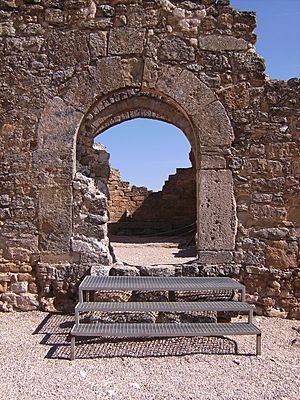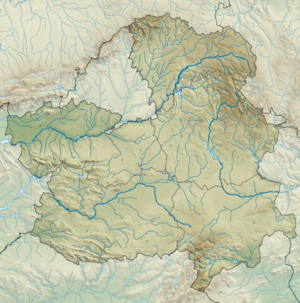Reccopolis facts for kids
 |
|
| Location | Zorita de los Canes, Province of Guadalajara, Castilla–La Mancha, Spain |
|---|---|
| Coordinates | 40°19′19″N 2°53′33″W / 40.32194°N 2.89250°W |
| Type | Settlement |
| History | |
| Founded | 578 |
| Abandoned | 9th century |
| Periods | Early Middle Ages |
Reccopolis (Spanish: Recópolis) was an important ancient city. It was built by the Visigoths, a Germanic people, in what is now Spain. You can find its ruins near the small village of Zorita de los Canes.
Reccopolis is special because it's one of only two cities known to have been founded in Western Europe between the 5th and 8th centuries. This time was known as the Early Middle Ages.
Contents
History of Reccopolis
Reccopolis was founded in the year 578. The Visigothic king, Liuvigild, created the city. He named it after his son, Reccared I.
Why the City Was Built
King Liuvigild wanted Reccopolis to be a special place. It was meant to be Reccared's main city. Reccared was a co-king in the Visigothic area called Celtiberia. This area was west of Toledo, which was the main capital.
Coins and Trade
Archaeologists found many coins in the city's palace. These coins show that Reccopolis was built around 580–583. The different types of coins found there show that the city traded with many places. Some coins were from other parts of Europe. Reccopolis also had its own mint (a place where coins are made). Coins from Reccopolis have been found from the early 700s.
Life Under Muslim Rule
In the 8th century, the Moors (Muslim people from North Africa) arrived in Spain. The Visigoths in Reccopolis agreed to be ruled by them. In return, the Moors protected the city. They called the city Madinät Raqquba.
Decline and Rediscovery
Over time, the city slowly declined. The Moors even reused some of its building materials. They built a fort on a nearby hill. Reccopolis was burned, robbed, and eventually abandoned in the 10th century. It was forgotten for hundreds of years.
The ruins of Reccopolis were not rediscovered until the 20th century. Today, it is a large field of ruins. There are plans to protect the site as an archaeological park. In 2007, a museum in Alcalá de Henares had an exhibition about Reccopolis.
City Design and Buildings
Archaeologists have learned a lot about Reccopolis's design. The city had strong walls with towers. It also had an aqueduct to bring in water. There were areas for shops and homes. The city covered about 30 hectares (about 74 acres).
The Palace and Upper City
The center of Reccopolis was a large palace. This palace was used by the king and for government work. It was connected to a special chapel. This design was similar to some buildings in the Byzantine Empire.
The city had a single main entrance gate on its western wall. Inside this gate, another gate led to an "upper city." This upper city included the palace and its chapel.
The Lower City
Outside the palace area was the "lower city." This part had homes for regular people. It also had business areas and a barracks for soldiers.
Inside the Palace
The palace itself had two stories. The bottom floor was a single large space. It might have been used as a granary (a place to store grain). The upper floor was likely the main living area. The roofs of the buildings were made of tiles, just like in Roman times.
The Palace Chapel
The palace chapel was a very important building. It might have been one of the last Visigothic Arian churches. Arianism was a type of Christianity. Later, a Romanesque church was built on top of its ruins.
The chapel was built like a basilica. It had a central main area called a nave. This nave was separated by solid walls from two side areas. These side areas led to a transept (the part of a cross-shaped church that crosses the nave). The chapel also had a rounded end called an apse. A deep entrance area, called a narthex, led into the chapel.
See also
 In Spanish: Recópolis para niños
In Spanish: Recópolis para niños





